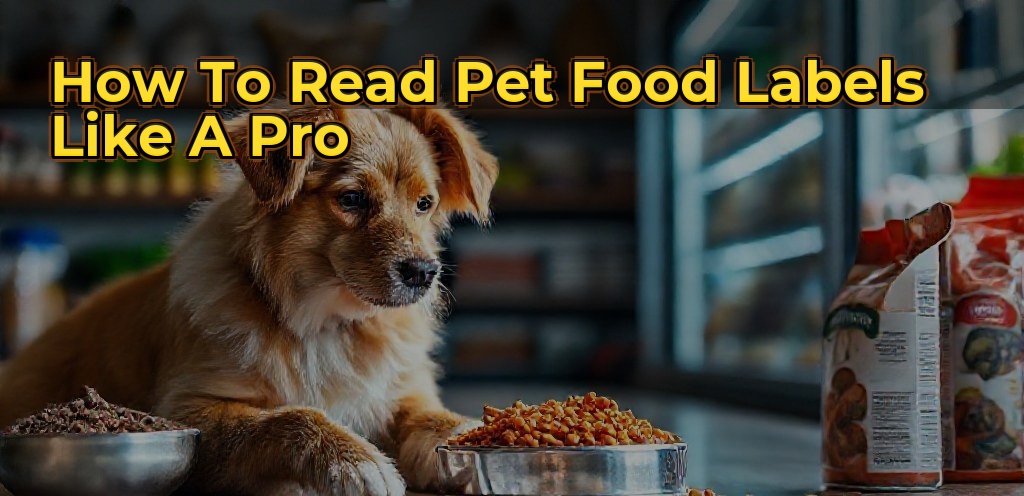How to Read Pet Food Labels Like a Pro
Ever stared at a bag of dog food-recipes-that-are-nutritious-and-easy/” title=”Homemade Pet Food Recipes That Are Nutritious and Easy”>food and felt like you need a PhD to decipher what’s inside? I’ve been there. Honestly, I once bought a seemingly healthy kibble because the label looked “impressive,” only to realize later it was packed with fillers and questionable additives. That experience knocked some sense into me—if you’re going to ensure your furry friend eats right, you’d better read those labels like a pro. But here’s the thing: most pet owners don’t know what to focus on, and I get it. Labels are full of jargon, tiny print, and marketing spin. So, in this guide, I’ll walk you through the tricks I’ve picked up over 15 years of learning the ins and outs of pet food labels, cutting through the noise to help you make smarter decisions.
Knowing Your Pet’s True Nutritional Needs
Understanding the Basics of Pet Nutrition
Before we even get into deciphering labels, I want to emphasize this: knowing what your pet actually needs is step one. Dogs and cats have different dietary requirements. For example, cats are obligate carnivores—they thrive on protein and can’t process plant-based ingredients as efficiently. Dogs are more omnivorous, but that doesn’t mean they can thrive on junk. Knowing your pet’s age, breed, activity level, and health issues guides your choices. I found that once I tailored the food to my pet’s specific needs, the quality of their coat, energy, and digestion improved noticeably.
Daily Nutritional Requirements at a Glance
Most commercial pet foods list “minimum” or “guaranteed” analysis — these show crude protein, fat, fiber, and moisture percentages. But those figures don’t tell the full story. Instead, aim for foods that meet or exceed Association of American Feed Control Officials (AAFCO) standards, which are developed based on pet life stages—growth, maintenance, or senior. For example, adult cats should get at least 26% protein on a dry matter basis; anything below that is suspect. Knowing these benchmarks helps you spot whether a product genuinely covers your pet’s needs rather than just sounding appealing or trendy.
Decoding the Front of the Package
The Product Name and Claims—What Do They Really Mean?
When I pick up a bag, I first glance at the name. Terms like “Beef & Vegetables” or “Grain-Free” catch the eye. But these aren’t standardized claims—they’re marketing. “Grain-Free” doesn’t mean grain is bad, just that it contains no wheat, corn, or soy. Sometimes it’s a way to charge a premium for a label that means little nutritionally. My advice: treat these as hints, not gospel. Instead, flip the bag and look for the guaranteed analysis and ingredient list to see what’s *really* inside.
Are “Natural” or “Holistic” Marketing Terms Trustworthy?
Honestly, not necessarily. Terms like “natural,” “holistic,” or “premium” often lack regulatory definitions, so I found it’s better to verify with the ingredient list. These words are designed to give consumers a warm, fuzzy feeling—sometimes at a higher price point. Rely on the ingredients and other facts rather than the labels’ marketing language.
Dissecting the Ingredient List Like a Chef
Order Matters—The First Few Ingredients Are the Star Players
The first 3-4 ingredients carry the most weight—they should typically be high-quality proteins or whole foods. I always look for real meat (like chicken, beef, salmon) or named meat meals, not vague terms like “meat by-product.” For example, a label reading “Chicken, chicken meal, peas, rice” is better than one that says “Meat by-products, wheat, corn.” If the first ingredient isn’t a meat or a quality meat ingredient, I get suspicious.
Watch Out for Fillers and Low-Quality Ingredients
- By-products: These aren’t necessarily harmful but suggest lower-quality sources. The key is knowing your pet’s threshold.
- Fillers: Corn, wheat, soy—used to bulk up food cheaply but offer minimal nutritional value. I avoid foods where these are the top ingredients.
- Artificial additives: Look for colorings, flavorings, preservatives like BHA, BHT, or ethoxyquin. My experience shows these can cause sensitivities in some pets.
- Always read the ingredient list before buying—top ingredients are your first clue.
- Compare guaranteed analyses across different brands for protein, fat, and fiber levels.
- Avoid vague terms like “meat by-product” unless you understand the source and quality.
- Check for certifications, safety seals, and batch codes—your peace of mind depends on it.
- Don’t be fooled by marketing buzzwords—rely on facts and specific info for good choices.
What About “Meat Meal” or “Fish Meal”?
Meat meal (like chicken meal, salmon meal) is concentrated protein, often more consistent in quality than fresh meat. It’s a good sign if the label specifies the type of meal, showing transparency. I’ve used formulas with high-quality meal ingredients that kept my pets healthy and energetic for years.
Genuine Certifications and Labels
What Do Certifications Actually Mean?
Look for certifications that back up quality claims. For instance, if a brand is grain-free, check if it’s USDA-approved or hasAAFCO compliance. Better yet, some brands carry third-party testing results for digestibility and safety. While this isn’t a guarantee of perfection, reputable brands don’t shy away from transparency.
Ensuring Product Stability and Safety
In my experience, those with clear expiration dates, batch codes, and safety seals are more trustworthy. Always check the seal—cracked or broken seals can compromise freshness and safety. Also, be wary of brands that change formula frequently without notice—stability matters.
Understanding Nutritional Guarantees and Claims
Guaranteed Analysis—Digging Deeper
The guaranteed analysis is a quick snapshot but can be misleading. For example, a food with 35% crude protein might seem high, but if it also contains a lot of filler, the actual digestible protein might be lower. I found that supplementing with fresh foods or treats helps fill in gaps when needed, especially if the label shows borderline levels.
Analyzing the “Calorie Content”
Calories per cup or per kilogram give better insight into how much to feed, avoiding overfeeding or underfeeding. Check the label for “calories metabolizable energy” (ME)—it’s a reliable measure. My rule: match calorie density to your pet’s activity level and health status, not just the package size.
The Hidden Nuances of Labeling Regulations
What Federal and State Laws Cover
In the US, the Food and Drug Administration (FDA) and AAFCO set standards, but enforcement can vary. I’ve learned to read between the lines—when a brand mentions compliance with AAFCO, it signals adherence to minimum standards, but not necessarily superior quality. Always cross-reference with ingredient transparency and third-party data when available.
When “Vegetarian” or “Vegan” Claims Are Involved
Personally, I’m skeptical about plant-based diets for obligate carnivores like cats and sometimes even for dogs. The label may look appealing, but in my experience, pets doing well on such diets have well-managed, carefully formulated meals. If you consider these options, dig deep into their claims and verify amino acid profiles—otherwise, it’s a gamble.
Practical Tips for the Informed Pet Owner
I remember the first time I bought a bag with a “natural” claim that turned out to be just marketing. Since then, I learned to scrutinize labels closely, focusing on real ingredients and nutritional facts. Making this a habit transformed how I care for my pets. It’s not about buying the most expensive or flashy brand; it’s about understanding what’s inside and whether it truly benefits your pet’s health.
Next, we’ll look at some of the most common label red flags and how to spot them at a glance, plus a checklist that I’ve personally used for years to vet pet foods efficiently. Ready to become a pet food label pro? Let’s dive deeper in Part 2.
Decoding Ingredients: What Truly Matters
When you pick up that bag of pet food, the ingredient list is your first line of defense. But it’s not just about scanning for familiar names—it’s about understanding what those ingredients tell you about the food’s quality, digestibility, and overall nutrition. The way ingredients are listed is based on weight, but that weight can be influenced heavily by moisture content. For example, fresh meat packed with water might appear at the top, yet after baking or processing, its contribution to nutrient density could be quite different.
Start by looking for ingredients you recognize—whole meats (like chicken, salmon, beef) should appear before any by-products or rendered meals. Whole meats indicate a higher-quality protein source, and while they can be more expensive, they usually offer a better amino acid profile. Rendered meals, such as chicken meal or fish meal, are concentrated protein sources and can be beneficial, but ensure they are the first few ingredients rather than fillers.
Beware of vague ingredients like “meat by-product,” “animal digest,” or “protein unspecified.” These can be processed to the point where their nutritional integrity is uncertain, and they often denote lower-quality ingredients. If you’re considering a food that lists several by-products, dig into the brand’s standards for sourcing and processing. Sometimes, reputable companies use these ingredients responsibly, but it’s worth asking yourself whether you’re comfortable with the ambiguity.
A good rule of thumb: look for ingredients that are named specifically and minimally processed. For example, “fresh chicken” or “salmon fillet” beats “meat by-product” every time. Also, check the order—ingredients listed first contribute the most to the formula. If you see vegetables or fruits high up in the list, that’s a positive sign, indicating fiber, antioxidants, and other phytochemicals. Just remember, produce can be added for marketing appeal more than nutrition, so look for specific types like “sweet potatoes,” “kale,” or “blueberries” instead of vague “plant ingredients.”
Nutritional Guarantees: What Numbers Really Tell You
Numbers on the bag—crude protein, fat, fiber, moisture—are standard, but they tell only part of the story. When comparing brands, look at the guaranteed analysis as a baseline, but then dive deeper into the nutrient profile. For instance, a food with 30% crude protein isn’t mutually superior to one with 25%, if the former relies heavily on cheap fillers and the latter uses high-quality animal proteins. Also, consider the metabolizable energy—the amount of energy pets actually get from the food—which the label might not specify but is critical for understanding caloric value.
Case study: I once tested a well-known brand with high guaranteed protein. On paper, it looked perfect—until I checked the amino acid profile, which hadn’t been disclosed on the label. Turns out, that “protein” was primarily from plant sources, which aren’t as bioavailable for dogs and cats. It reminds us: numbers matter, but they only tell a partial story unless you look at the full macro and micronutrient profile.
Pro tip: keep an eye out for foods that specify the amino acid sources—like “chicken meal,” “salmon,” “lamb,” rather than generic terms. Also, trace minerals like zinc, selenium, and iron should be listed explicitly, indicating they’re added intentionally rather than as contaminants.
Special Dietary Needs and Allergen Concerns
Every pet has unique needs—trekking through gluten sensitivities, grain allergies, or weight management. Reading labels carefully helps you detect potential triggers or deficiencies. For instance, if your cat has grain sensitivity, steer clear of foods with corn, wheat, or soy listed prominently. For dogs needing joint support, look for ingredients like glucosamine, chondroitin, or omega-3 fatty acids from fish oils.
Case example: I had a client whose Labrador developed itchy skin. After scrutinizing the label, I noticed a food with a high level of beef and wheat. Swapping to a limited-ingredient diet with a novel protein such as duck and avoiding common allergens visibly reduced her symptoms in weeks. The point? Ingredients and their order, combined with understanding your pet’s health profile, make a huge difference.
Another critical aspect is reading for added supplements. Many foods list added vitamins, minerals, or functional ingredients—like probiotics, antioxidants, or anti-inflammatory compounds. These can be game-changers for certain pets. But, verify their inclusion with independent research, and ensure that their quantities align with your pet’s needs.
Certifications and Quality Control
It’s tempting to rely solely on labels, but certifications provide an extra layer of assurance. Look for brands that adhere to standards set by organizations like the Global Food Safety Initiative (GFSI), or those with Health Canada, AAFCO, or USDA approval. Batch codes and manufacturing dates matter as well—know that fresher food often maintains better nutrient integrity. Also, check for safety seals and tamper-evident packaging—these little details protect your pet from compromised products.
Some brands undergo ingredient verification by third-party auditors. Such transparency indicates a commitment to quality, which is reassuring when you’re making a long-term investment in your pet’s health.
Case Studies: Beyond the Label
One example I always recall involves a pet food brand that raved about their “grain-free” formulas. Yet, a deep investigation revealed their primary carbohydrate source was tapioca—their claim was true but somewhat misleading. Tapioca isn’t inherently bad, but it’s still a processed ingredient that may lack the fiber benefits of whole grains or vegetables.
Another lesson comes from a mid-tier brand that listed animal protein first, but after contacting the manufacturer, I learned the formula relied on a low-value protein concentrate. Still, the label’s prominence can be deceptive. Digging into manufacturer transparency can save you from spending on something that underdelivers nutritionally.
Final Thoughts
Peeling back the layers of pet food labels requires a bit of detective work, but it’s highly rewarding. Recognize that quality ingredients, transparent labeling, and comprehensive nutritional profiles create the foundation for your pet’s well-being. Don’t settle for marketing hype or vague terms—demand specifics, ask questions, and stay informed. Remember, your pet’s health is worth the effort.
Start by making a short list of trusted brands known for transparency. Use online resources, forums, and reviews—many experienced pet owners share insights on ingredient sourcing and manufacturing standards. Experiment with different formulas if needed, but always prioritize foods that meet your pet’s individual needs and your standards for quality.
Next steps? Keep scrutinizing ingredient lists, refine your understanding of nutritional labels, and consult with your veterinarian about specific dietary adjustments. If you’re ever in doubt, request detailed breakdowns or seek an independent pet nutritionist’s opinion. Ultimately, the goal is simple: empower yourself to choose foods that nourish, support, and keep your furry friends thriving for years to come.





